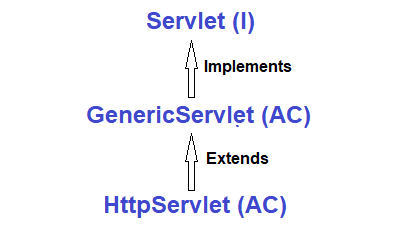Servlet Service Method. Servlet API gives 2 service methods to place request processing logic in the servlet component (class). Those service(-,-) methods are:-
- public void service(ServletRequest req, ServletResponse res) throws ServletException, IOException:- It is a public method declared in Servlet interface. This method doesn’t support HTTP features.
- protected void service(HttpServletRequest req, HttpServletResponse res) throws ServletException, IOException:- It is a protected method directly defined in HttpServlet class, and it supports HTTP features.
Among them only the first Servlet Service Method i.e. public service(ServletRequest req, ServletResponse res) method is the life cycle method, the remaining other method is convenience methods given to the programmers.
public service(ServletRequest req, ServletResponse res)
Prototype:- public void service(ServletRequest req, ServletResponse res) throws ServletException, IOException
It is originally declared in jakarta.servlet.Servlet(I) and maintained as abstract method in jakarta.servlet.GenericServlet(AC) and implemented in jakarta.servlet.http.HttpServlet class(AC).

It is the servlet life cycle method and it will be executed when the servlet container calls it for the request processing event. When the request processing event is raised then our servlet Class object is created, initialized, and ready for request processing. This method doesn’t support HTTP features.
protected service(HttpServletRequest req, HttpServletResponse res)
Prototype:- protected void service(HttpServletRequest req, HttpServletResponse res) throws ServletException, IOException
This is not the life cycle method, it is a convenience method and directly defined in HttpServlet(AC). This method supports HTTP request methods like the GET, POST, HEAD, PUT, and e.t.c. This service(-,-) method is internally called through the first service i.e. public service(ServletRequest req, ServletResponse res) method.
Limitation of Servlet Service Method
Both service(-,-) method given in HttpServlet class is capable of processing requests given by the client (like browser software, FTP, and e.t.c.) but it has the following several limitations:-
- The protected service(HttpServletRequest req, HttpServletResponse res) method support HTTP features, but public service(ServletRequest req, ServletResponse res) method doesn’t support HTTP feature.
- Both service methods don’t provide any environment to write separate request processing logic for the HTTP modes of request like the GET, POST mode requests.
- Basically, the service method is not designed based on protocol HTTP standards to process different ways/modes of request:- GET, POST, PUT, DELETE, OPTIONS, TRACE, and HEAD.
- HttpServlet class contains two service methods, and it is confusing the developers.
To solve all these problems we should use the doGet and doPost method in our servlet component, and it is the standard approach used in web application development. In doGet(-,-) and doPost(-,-) in the servlet tutorial, we will discuss how we should write the logic for the GET and POST mode requests. In the HttpServlet class tutorial, you will get in-depth knowledge about both service(-,-) and doXxx(-,-) methods.
Conclusion:- It is not recommended to use the service(-,-) method in our servlet component for request-processing. Rather we should use doGet(-,-), and doPost(-,-) methods.
If you enjoyed this post, share it with your friends. Do you want to share more information about the topic discussed above or do you find anything incorrect? Let us know in the comments. Thank you!